Wisteria trellises are an excellent way to add beauty and privacy to your garden or outdoor space. Whether you’re looking for a simple, classic design or something more intricate and eye-catching, wisteria trellis ideas can help you create the perfect look. Not only do these structures provide shade from the sun, but they also help support climbing plants like wisteria as they grow up towards the sky. With so many options available, it’s easy to find a style that suits your taste and budget. From traditional arches and pergolas to modern lattices and metal screens, there is sure to be a wisteria trellis idea that will bring life to any outdoor space.
How Tall And Wide Will My Wisteria Plant Climb?
Before you choose a wisteria trellis, it is important to consider the size of your wisteria plant.
For smaller spaces, a simple arch or pergola will work well. For larger gardens, more intricate designs like lattices or metal screens can be used to create an impressive statement piece. Whichever style you choose, make sure the trellis is tall and wide enough for your wisteria to climb up and around.Which Type Of Trellis Is Best And How Much Support Will My Wisteria Need?
When it comes to choosing the best trellis for your wisteria, there are a few things to consider. The first is the type of trellis you want to use. Popular options include wood lattice or metal frames. For larger varieties, such as Chinese and Japanese wisterias, a more substantial support structure may be needed.

The second thing to consider is how much support your wisteria will need. Climbing wisterias are heavy, so they tend to require more support than smaller varieties. If you’re using a wood trellis, it should be placed in an area that won’t be too exposed to the elements and should be reinforced with metal braces for extra support. Metal trellises are more durable and require less reinforcement, but they also tend to be more expensive than wood varieties.
Finally, you may want to consider the aesthetics of your wisteria trellis when making your decision. Consider the size, shape, color and texture of the trellis and how it will complement your garden. You should also decide whether or not you want a decorative trellis, such as one with intricate details or a more simple design. [1]
Trellis Ideas
When it comes to growing wisteria, the key is finding the right trellis ideas. A strong and well-designed trellis can provide support for your wisteria vines as they climb and spread along its structure. Here are some of our favorite trellis ideas when it comes to growing wisteria.
Designate Rooms
To create distinct spaces in your outdoor area, consider adding a wisteria trellis. Not only will it add visual interest to the area, but it can also provide a sense of separation and privacy between two areas.
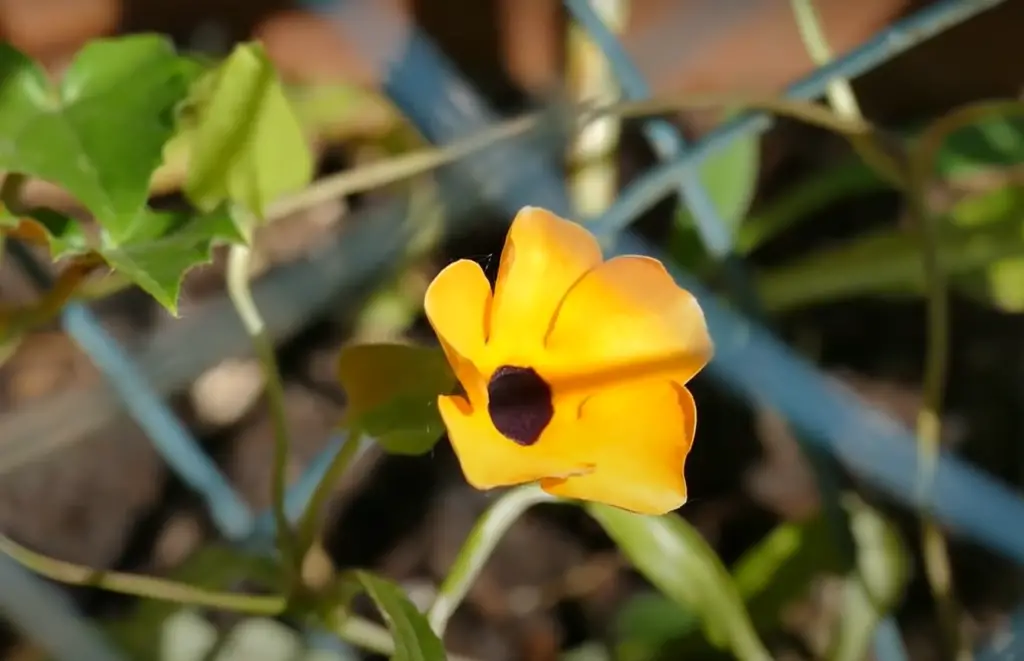
For example, you could use a trellis covered in wisteria vines to designate a dining area or an outdoor kitchen. This will give the space additional definition and make it feel like its own separate room.
Pretty Patio
If your garden area is a bit more limited, but you still want to add some vertical interest and a cascade of beautiful blooms, then consider planting a wisteria trellis along the side of your patio. This can be done as an independent structure or as part of a larger pergola. Either way, you can create a stunning look with the wisteria, and it will fit nicely into your patio space. You may even want to add some additional plants around the base of the trellis for added color and interest. With this style, you’ll get plenty of shade in the summertime, plus gorgeous blossoms all season long. [2]
Sweet And Seasonal
Whether you are looking for a classic, whimsical, or modern look for your outdoor space, wisteria trellises can provide the perfect touch. With its graceful branches and cascading clusters of flowers, wisteria is an excellent choice for any garden. Here we have gathered some ideas to get you started on your perfect wisteria trellis design. For a classic look, choose a traditional wood trellis and train the wisteria up it. Consider adding some additional plants such as ivy or roses to add another layer of colour and texture to the trellis. You could also mix in some metal pieces for a more contemporary feel. For a whimsical look, try creating an arbor or pergola with wisteria vines. This will give your garden a unique and inviting atmosphere. You could also add in hanging baskets of colourful flowers to draw the eye upward and create an interesting focal point. If you are looking for a modern take on wisteria trellises, consider using metal or aluminum trellises.
Criss-Cross
A classic criss-cross design is a popular option for wisteria trellises. This style of trellis provides plenty of space for the plant to spread out, as well as supporting its weight. The criss-cross pattern is easy to construct and looks great in any garden.
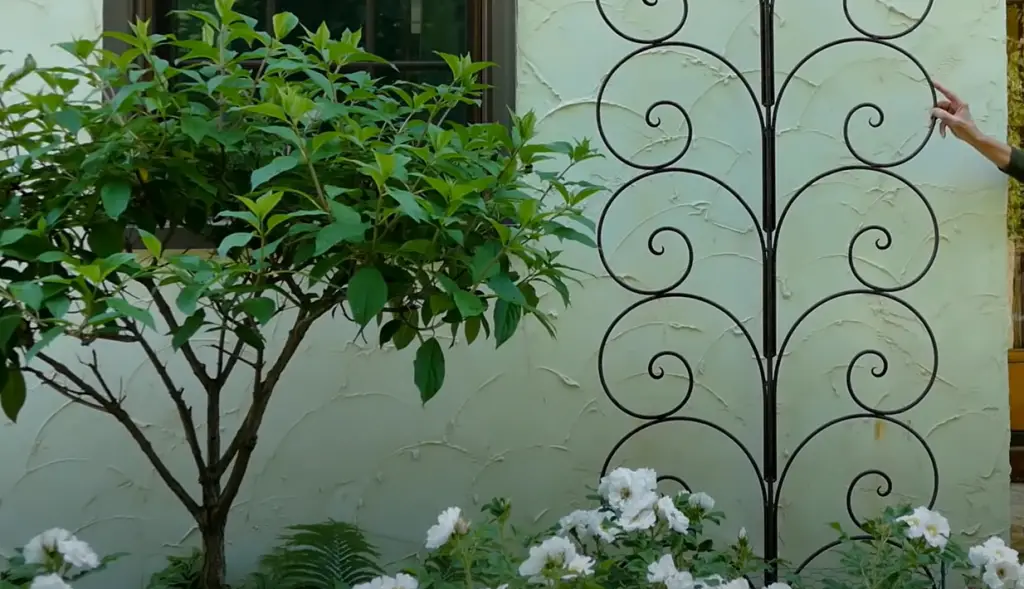
To create this type of trellis, simply use wooden posts to frame the structure. Then connect the vertical and horizontal pieces with galvanized screws or nails. Alternatively, you can use metal trellis panels that are already angled into a criss-cross pattern.
Welcome Wisteria
Wisteria can bring a beautiful and elegant look to your garden. With its cascading flowers and lush foliage, adding wisteria to your landscape is sure to be a showstopper.
This guide will provide some ideas for building a wisteria trellis, as well as helpful tips on how to properly care and maintain your climbing vine. [3]Set The Mood
Turn your garden into an enchanted escape with a wisteria trellis. These lovely flowering vines have been gracing gardens for centuries and are known for their long, cascading blooms in purple, blue, or white. The best part is that these gorgeous plants can be trained to climb along trellises and wire fencing to create captivating displays.
Rope In
This trellis is a great way to bring some architectural interest to your garden. It consists of four sturdy posts and thick rope wrapped around them in an inverted pyramid pattern. This design provides plenty of support for heavy wisteria vines, and the lines created are visually stunning when the blooms appear.
Other Species And Advice
There are many varieties of wisteria that can be grown as a trellis.
American Wisteria (W. frutescens) is a smaller, lesser-known species with short clusters of fragrant white flowers.If you’re looking for a showstopper, consider the hybrid varieties like ‘Amethyst Falls’ or ‘Blue Moon’, both flowering for as long as five weeks.
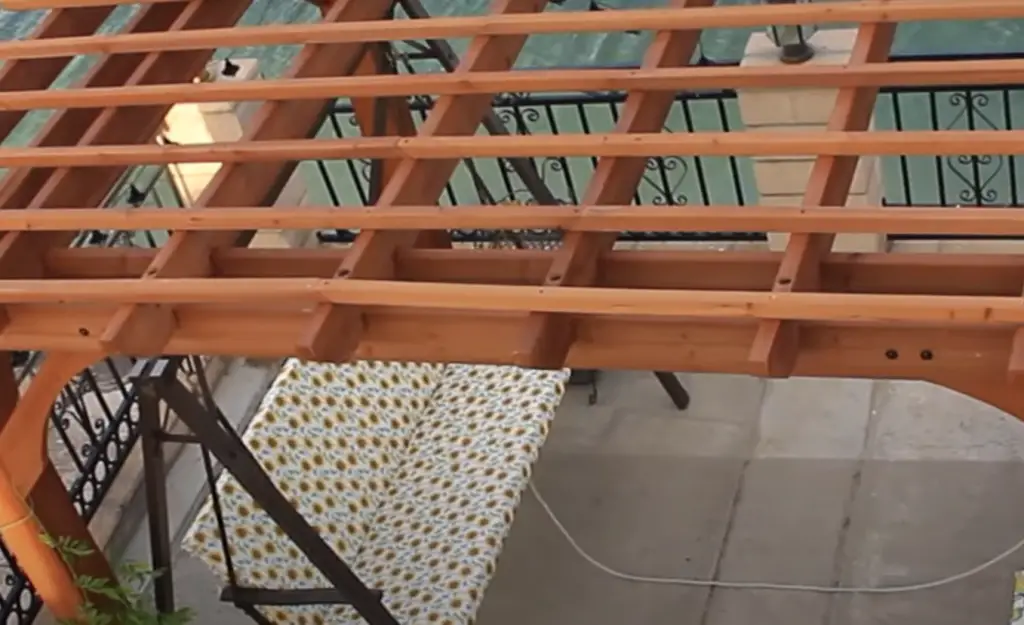
No matter what type of wisteria you choose, it’s important to properly train and prune your trellis throughout the growing season. To ensure successful flowering, prune your wisteria as soon as possible after it finishes blooming each year. This will ensure that only strong, healthy shoots remain and keep the trellis looking its best. [4]
FAQ
What kind of trellis is best for wisteria?
The best trellis for wisteria is one made of a sturdy, lightweight material like wood or metal. It should be able to support the heavy vines and flowers, while also allowing them to climb up easily. The ideal height would be around eight feet tall so that the wisteria can have plenty of room to grow. Additionally, since wisteria needs sunlight to thrive, the trellis should be placed in an area that receives plenty of sun.
What is the best support for wisteria vines?
The best support for wisteria vines is a trellis. Trellises provide structure to climbing plants like wisterias and help them stay upright while they grow. Wisteria trellises come in many shapes and sizes, from simple single-post trellises to formal arbors with intricate lattice designs. Some trellis designs are made of metal, while others are crafted from wood or even plastic. No matter the material used, a well-made wisteria trellis can add beauty and elegance to any garden or outdoor space.
Here are some inspiring wisteria trellis ideas to get you started
- Pergola: A pergola adds a grand touch to any outdoor space. It is traditionally made of wood and has an open roof with beams that can support the weight of vines such as wisteria. The design creates a shaded walkway or seating area in the garden.
- Arched trellis: An arched trellis is a classic and elegant design that can be used to support wisteria or other climbing plants. It adds an air of sophistication while providing strong support for the vines.
- Lattice wall: For smaller spaces, a lattice wall can provide support for wisteria vines while also creating a beautiful backdrop in the garden. The pattern of the lattice adds visual interest to the landscape.
- Privacy fence: For larger gardens, a privacy fence can be used to support wisteria vines while also providing additional privacy for the garden space. The wisteria will grow up and over the fence, creating an attractive green wall that can block out unwanted noise or views from neighbors.
Do you need a trellis for Wisteria?
A trellis is a great way to support the wisteria plant while it grows and climbs. Wisteria trellises can be made of wood, metal, or plastic and are an attractive addition to any garden. When deciding on a trellis for your wisteria, consider the size and shape of the trellis, as well as the material that it is made of.
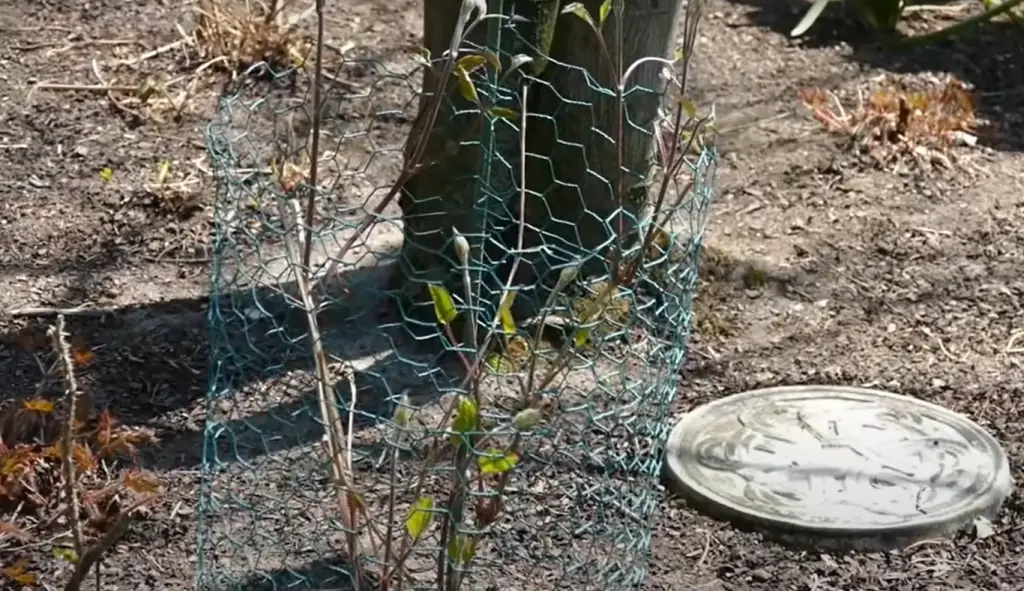
When selecting a trellis for your wisteria, keep in mind that it must be able to support the weight of the growing plant. A metal or plastic trellis is strong enough to handle larger plants, while a wooden trellis may be better suited for smaller plants. It is important to make sure the trellis you choose is sturdy and well-built, as it will be in place for many years.
How do you put wisteria on a trellis?
Adding wisteria to a trellis is an easy way to create a stunning garden feature. To begin, you will need to choose the right type of trellis for your wisteria. There are many different types available, including metal and plastic panels or arched wooden lattices. Once you have chosen the best trellis for your garden, you need to prepare the area. Make sure that the trellis is firmly secured in the ground and positioned in a sunny spot. Before planting your wisteria, you should prune it back to encourage more growth. This can be done by cutting away any dead or dying branches with a pair of gardening shears. Once the wisteria has been pruned, you can begin planting it on your trellis. If you are using a metal or plastic panel trellis, use scissors to create small holes in the material. Plant each stem into one of these holes and secure with string or wire ties if necessary. For wooden trellises, use a drill to create holes in the wood and then plant each wisteria stem in one of these. Secure the wisteria plants with screws or ties for extra support. Once your wisteria is securely attached to the trellis, you can start training it by wrapping the stems around the lattice work. You can use guidance wires or ties to help shape and encourage the wisteria to grow in a certain direction.
How deep do wisteria roots go?
The depth of wisteria roots depends on the species. While some varieties may have shallow roots, others can grow up to 10 feet deep! Wisteria is a vigorous vine that needs ample room for its roots to spread and thrive. For this reason, it’s important not to plant them near structures or in compacted soil. If you’re considering planting wisteria, it’s best to keep the roots away from foundations, walls and pipes. Additionally, if your soil is exceptionally hard/compacted or rocky, consider adding a layer of topsoil before planting. This will help ensure that the root system has plenty of room to grow and expand. When planting a trellis for wisteria, make sure you install it at least six feet away from any structures to avoid potential damage. Additionally, use posts that are buried 18-24 inches below the surface and reinforced with concrete or gravel. This will help ensure that your trellis is secure and can withstand the weight of this vigorous vine. With proper planning and care, your beautiful wisteria trellis will provide years of enjoyment.
Do wisteria prefer sun or shade?
A wisteria will thrive in a spot that receives six to eight hours of direct sunlight per day. If the trellis is in an area with less light, you may need to supplement the natural sunlight with artificial lighting such as grow lights. However, too much sun can cause the leaves to yellow and burn so some shade should be provided during the hottest parts of the day.
What is the best way to stake wisteria?
The best way to stake wisteria is through a three-dimensional trellis. This trellis should be made out of strong material, such as metal or plastic, and have thick wires that can support the weight of the vine. It should also include horizontal supports for the main stems and branches to grow along. Positioning the trellis in an area that receives plenty of sunlight and has good air circulation will also benefit the plant. Additionally, it is best to stake the trellis firmly into the ground with stakes or rods for added stability.
How quickly does wisteria grow?
Wisteria is a fast-growing vine and can quickly reach heights of 20 feet or more. Depending on the variety, it can grow up to 10 feet in one season.
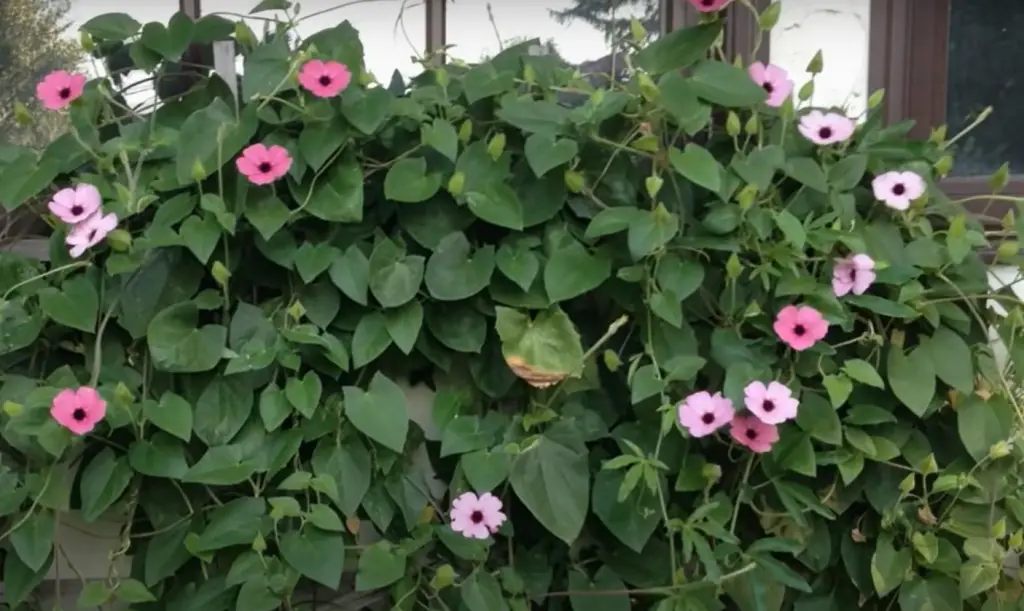
However, growth rate varies based on climate, soil conditions, and other factors such as pruning and fertilizing. In addition to height, wisteria can also grow up to 10 feet in width per season.
How do you control wisteria vines?
Controlling wisteria vines is an important part of creating a beautiful and practical trellis. Wisteria are vigorous climbers, with their stems twining around any support they come into contact with. If left unchecked, they can quickly become unruly. To keep your wisteria under control you must regularly prune the shoots and train the stems to grow in the desired direction. Begin by pruning the wisteria immediately after flowering, removing any shoots that have grown outside of your planned trellis area. You’ll also want to remove any dead or damaged branches. This will encourage lateral growth rather than vertical growth and help contain the plant within its allotted space. When training your wisteria, you’ll want to begin in the early spring. Begin by tying the main stem of the vine to the support structure with soft twine or a flexible wire. As side shoots appear and grow, gently tie them to wires running horizontally along the trellis. This encourages lateral growth rather than vertical growth and helps contain the plant within its allotted space. As the vine continues to grow, continue training new branches in this manner. Pruning should also be done regularly throughout the growing to keep your wisteria well-maintained and looking beautiful.
What size trellis for wisteria?
When choosing the size of trellis for your wisteria, you should first consider how large and vigorous the particular variety of wisteria is. If it is a smaller variety that doesn’t grow as quickly or reach a height of more than 5 feet, then a shorter trellis (up to 6 feet) may be adequate. On the other hand, if you have a larger variety that grows quickly and can reach heights of up to 15 feet, then you will need a taller trellis (up to 10 or 12 feet). Be sure to check the mature height and spread of your wisteria before deciding on which size of trellis is best for your garden.
What grows well with wisteria?
Wisteria is a beautiful and fragrant climbing vine that has been traditionally used for decorating trellises. It’s also popular because it’s easy to maintain and can grow rapidly, so you won’t have to wait very long before your trellis is covered with flowers. To get the most out of your wisteria, you should consider pairing it with other plants that will complement its beauty and provide additional support. Some of the best plants to grow alongside wisteria include clematis, jasmine, roses, and ivy. All of these climbing vines require a trellis for support, so they can make a great addition to your wisteria trellis. In addition to other climbing plants, you can also add other shrubs and trees to your wisteria trellis for even more beauty and texture. Some great options include dogwood, magnolia, or apple trees. These will provide extra support for the wisteria as it climbs and will help keep it from overtaking other plants in the area. Finally, to add more color and texture, you can also plant some flowers at the base of your wisteria trellis. Pansies, lavender, and daisies are all great options for adding a splash of color around your trellis.
Useful Video: How To Build A Beautiful Wisteria Garden Arch – Garden Trellis – Garden Arbor In Just A Few Minutes!
Conclusion
When looking for a beautiful way to add some greenery and height to your outdoor spaces, consider installing a wisteria trellis. Whether you choose a metal or wood frame, it will be sure to bring an elegant and sophisticated touch to your garden area. There are so many different design ideas that you can explore when considering the placement of your trellis and the type of wisteria to use. Be sure to keep in mind factors like the amount of sun exposure, soil condition, and climate that will affect how your wisteria grows before you get started. With a little bit of planning and research, you can create an attractive outdoor feature that will add beauty to your garden area for years to come.
References:
- https://www.gardenpatch.co.uk/which-trellis-is-best-for-wisteria/
- https://www.wikihow.com/Build-a-Trellis-for-Wisteria
- https://homeguides.sfgate.com/build-trellis-wisteria-37414.html
- https://www.southernliving.com/trellis-ideas-7229638










Leave a Reply
View Comments